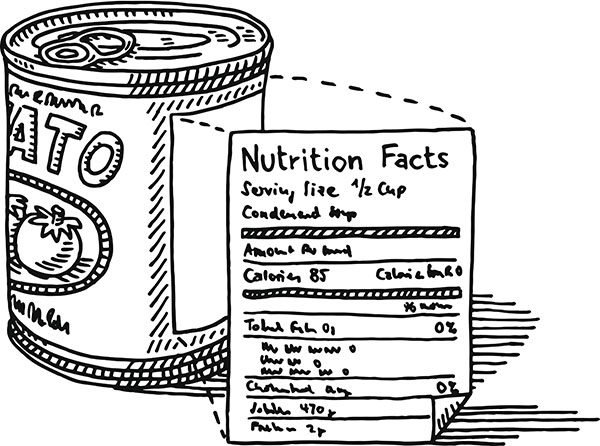In the modern era of food choices, where supermarket shelves are stocked with an array of products vying for our attention, understanding food labels has become a crucial skill. Behind the flashy packaging and enticing claims lies a wealth of information that can shape our dietary decisions. Food labels serve as our compass, guiding us toward choices that align with our nutritional needs and health goals. In this comprehensive guide, we embark on a journey of unraveling the mysteries of food labels, equipping you with the knowledge to navigate the aisles of the grocery store with confidence and mindfulness. From deciphering serving sizes to unraveling nutrient content and uncovering hidden ingredients, this guide is your key to making informed choices that contribute to a healthier and more informed lifestyle.
Decoding Food Labels: A Closer Look
In this section, we’ll dive into the intricate components of food labels, unraveling the information they hold and empowering you to make informed choices.
1. Serving Size and Servings Per Container Understanding serving sizes is the foundation of interpreting food labels. Let’s break down what this means and why it matters.
Example: Imagine you’re eyeing a bag of whole-grain cereal. The serving size is 1 cup, and there are 8 servings per container. If you consume the entire container, you’re actually having 8 cups’ worth of cereal, not just 1.
2. Calories and Calories from Fat Calories provide a snapshot of the energy a food provides. We’ll explore how calories and calories from fat play a role in assessing nutritional content.
Example: Consider a can of vegetable soup with 150 calories per serving, including 30 calories from fat. This means that 20% of the calories come from fat.
3. Nutrient Content Delve into the world of macronutrients and micronutrients listed on food labels. Discover how to interpret nutrient content for a well-rounded perspective.
Example: Picture a granola bar boasting 5 grams of protein, 20 grams of carbs, and 8 grams of fat per serving. These values offer insights into its nutritional composition.
4. Nutrient Contribution to Health Certain nutrients play key roles in our well-being. Let’s explore how food labels highlight their contributions to health.
Example: A yogurt cup might indicate 15% of the daily recommended value for calcium, emphasizing its support for bone health.
5. % Daily Value (%DV) The %DV provides context for nutrients within your daily intake. Let’s uncover its significance and practical application.
Example: On a bag of pretzels, the sodium content is listed as 12% DV. This means one serving contributes 12% of your daily sodium intake based on a 2,000-calorie diet.
6. Nutrient Claims and Health Claims Learn to navigate claims like “high in fiber” or “low-fat” on food labels. Understand their implications and how to assess their validity.
Example: A cereal box may proudly declare its “high fiber” content. However, it’s crucial to consider the entire nutritional profile to make an informed choice.
7. Ingredient List The ingredient list unveils the contents of a product. Discover how to decode this list and make educated decisions based on its information.
Example: A jar of tomato sauce lists tomatoes, olive oil, onions, garlic, and spices. This transparency lets you know exactly what you’re consuming.
8. Allergens and Sensitivities Food labels provide crucial allergen information. Learn how to identify potential allergens to ensure your safety.
Example: A loaf of bread’s label might say “Contains: Wheat, Soy.” This alerts individuals with wheat or soy allergies to avoid the product.
9. Additives and Preservatives Explore the realm of additives and preservatives found in many processed foods. Understand their role and implications for your health.
Example: A frozen dinner’s ingredient list includes additives and preservatives, indicating a higher level of processing.
Making Informed Choices: Practical Tips
Transitioning to practical advice, let’s explore actionable steps you can take to decipher food labels and make healthier choices.
1. Compare Labels When faced with similar options, comparing labels can be enlightening. Learn how to spot differences and make smarter choices.
Example: Choosing between two cereal brands? A quick label comparison might reveal that Brand A has fewer calories and sugar than Brand B.
2. Prioritize Whole Foods Discover the value of whole foods and how they contribute to your well-being. Get tips on making wholesome choices.
Example: Instead of flavored yogurt cups with added sugars, opt for plain Greek yogurt and add fresh fruits for natural sweetness.
3. Be Skeptical of Health Claims Learn to critically assess health claims on food labels. Understand when they hold true value and when they might be misleading.
Example: Labels boasting “low-fat” might not tell the whole story. Always consider the full nutritional profile to make an informed choice.
4. Tailor to Your Needs Personalize your food choices based on your dietary goals and preferences. Discover how to tailor labels to fit your nutritional needs.
Example: If you’re aiming to increase fiber intake, choose a whole-grain pasta with a higher %DV for fiber.
5. Look Beyond Calories Shift your focus from just calorie counts to nutrient density. Learn why nutrient-rich foods should be at the forefront of your choices.
Example: Opt for nutrient-dense snacks like nuts that provide healthy fats and protein alongside calories.
6. Learn Ingredient Lingo Become savvy in understanding ingredient names and their implications. Equip yourself with knowledge to make better choices.
Example: Recognize that “high-fructose corn syrup” and “corn syrup” are added sugars. Opt for products with minimal or no added sugars.
7. Plan Balanced Meals Discover how to use food labels to build well-balanced meals that encompass a variety of nutrients. Learn the art of meal planning.
Example: If your lunch includes a sandwich with fiber-rich bread, focus on adding protein and vegetables for a balanced meal.
